| Reviews & Columns |
|
Reviews DVD TV on DVD Blu-ray 4K UHD International DVDs In Theaters Reviews by Studio Video Games Features Collector Series DVDs Easter Egg Database Interviews DVD Talk Radio Feature Articles Columns Anime Talk DVD Savant Horror DVDs The M.O.D. Squad Art House HD Talk Silent DVD
|
DVD Talk Forum |
|
|
| Resources |
|
DVD Price Search Customer Service #'s RCE Info Links |
|
Columns
|
|
|
History Channel: America at War Megaset, The
VOLUMES ONE - THREE: THE REVOLUTIONARY WAR
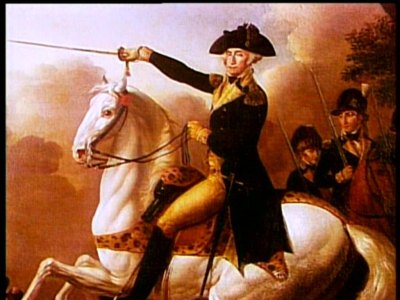
The American Revolution: The Conflict Ignites
Before the "shot heard around the world," better known as the Battle of Old North Bridge, the conflict that erupted into the American Revolutionary War began as a war of ideas. With the passionate support of activists like Patrick Henry and Samuel Adams, as well as statesmen like Benjamin Franklin, the economic credo "no taxation without representation" swiftly evolved into rallying cries of "Liberty or death!" and grand revolutionary themes such as "All men are created equal."
The American Revolution: 1776
The Virginian George Washington, selected by the Second Continental Congress to command the Continental Army, was the first of many brilliant military leaders to answer the call of Liberty. As Ethan Allen and his Green Mountain Boys, alongside others, took on the British at Ticonderoga and Quebec, John Adams, Benjamin Franklin, and Thomas Jefferson shaped history in Philadelphia by drafting the Declaration of Independence.
The American Revolution: Washington and Arnold
On Christmas night 1776, Washington led twenty-four hundred cold and weary warriors across the Delaware River. This masterful attack on Trenton turned the tide of the war, building momentum for General Horatio Gates' and Benedict Arnold's subsequent triumph at Saratoga. Across the Atlantic, Benjamin Franklin waged an equally important - and successful - campaign to convince the French Court to recognize his fledgling nation and declare war on beleaguered England.
The American Revolution: The World at War
The war in the American colonies caused ripples around the world as France and Spain saw an opportunity to capitalize on the economic and military pressure bearing down on their traditional enemy, Great Britain. At Valley Forge, Washington's men were trained under Prussian military instructors, preparing them for the inspiring Battle of Monmouth. Meanwhile, frontiersmen George Rogers Clark and Daniel Boone waged a merciless insurgent campaign on America's Western Frontier.
The American Revolution: England's Last Chance
As the war lurched into its fifth bloody year, Benedict Arnold made a deal with the British to hand over the "key to the continent" - West Point. At sea, American privateers crippled British commerce, while France and Spain waged a naval war on Britain in the West Indies. Brutal leaders like Banastre "The Butcher" Tarleton helped the British dominate the South, until Nathaniel Greene forced Commander Cornwallis to retreat to Virginia.
The American Revolution: Birth of the Republic
At the Battle of Cowpens, General Daniel Morgan destroyed the bulk of Tarleton's legion, allowing Nathaniel Greene to drive Cornwallis all the way back to Virginia. Seizing opportunity, Washington leveraged French naval power to a decisive victory at Yorktown. The war officially ended with the Peace of Paris, which secured American independence. The Constitutional Convention drafted the historic document that united the victorious colonies as "We, the People of the United States."
Lavishly produced on-location in 1994 with a comprehensive sweep heretofore unseen for a documentary on our nation's birth war, writer Don Cambou (a veteran producer of TV docs, including the terrific series, Modern Marvels) and director Lisa Bourgoujian have fashioned a quickly-moving 293 minute examination of the causes that led up to the War of Independence, as well as the pertinent battles and events that shaped the long, long conflict, and their aftermaths. It's shameful to admit, but I confess knowing far too little about the single most important event - both politically and militarily - in our nation's history (school never seemed to bring this critical historical period to life for me), so I was genuinely impressed (and enlightened) with the overall scope and depth of this project.
Utilizing the standard A&E documentary format of 1): a re-created scene or staged battle, followed by 2): a "talking head" expert explaining said re-creation before setting up the next one, to 3): a representative painting, or print, or shot of an historic building for illustration of the discussed event or theme, followed by 4): perhaps an authentic diary recitation, read by some famous actors (Kelsey Grammar, Charles Durning, Michael Learned, Cliff Robertson, Rick Schroder, and William Daniels lend their particularly heavyweight acting chops to this production), The American Revolution presented not only the familiar signposts of our war against Britain (Paul Revere's ride, John Adams championing George Washington to the Continental Congress), but also highlighted "side events" (which are by no means lesser for not being less-well known) that I found fascinating. "Forgotten" (i.e.: not remembered or learned by me) figures such as the heroic, incongruous book seller Henry Knox, who managed to lumber 50 cannons through a grueling snow storm to Fort Ticonderoga's battlements, was an incredible feat of unlikely engineering and raw courage; or Israel Putnam being named as the author of the stirring cry to battle we've all heard, "Don't fire unto you see the whites of their eyes!" at the Charlestown Peninsula fort; or the detailing of Benedict Arnold's incredible foot campaign to march on Quebec (I had totally forgotten we even engaged on Canadian soil during the war); or Abigail Adams' letter to her husband John, threatening a female revolt (!) if women weren't included into the Revolutionary equation. If I had heard or read about these events before, I didn't remember them, but The American Revolution brought them vividly to life for me (my older teen was particularly fascinating as well by this section of history - a period he too stated isn't properly covered in school).
Expert historians, authors, and commentators such as General John Galvin, George F. Scheer, Piers Mackesy, Thomas Fleming, Gordon S. Wood, Dave Palmer, Don Higginbotham, Nicholas Rodger, R. S. Stephenson, Janice Potter-Mackinnon, Jonathan Dull, Anthony Tommell, Dr. Gary Wheeler Stone, Howard E. Mitchell, and Barbara Oberg guide us through the conflict (which was far more intricate and delicate and decidedly not "inevitable" - often times on the verge of defeat - than is usually portrayed in other docs), bringing in peripheral events, as well, that deepened this revolutionary portrait (I found the discussion of guerilla warfare west of the traditional 13 colonies to be particularly fascinating, as well as the fact that European powers continued to fight in the West Indies two years after colonial hostilities ceased). Gorgeously shot by I-Li Chen and Dan Waymack (although the video quality of this transfer leaves a lot to be desired), with appropriately stirring music by Zeljko Marasovich and Christopher L. Stone, The American Revolution flies by during its nearly five-hour running time, no doubt aided by the snappy editing of Michael Andrews and Stephen Pomerantz. Focusing on not just the military aspects of the war, but also heavily on the root causes that inspired the colonists to revolt (some of which may surprise the viewer), The American Revolution is a necessarily primer and terrific starting point for anyone interested in the roots of this country's tumultuous birth.
VOLUME FOUR: THE ALAMO
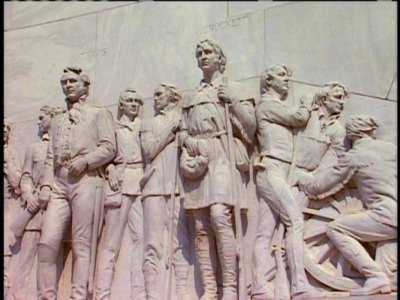
The Alamo: Remember the Alamo
As a half-century of hostilities erupted in the Texas Revolution, a small group of filibusters, Texians, and Tejanos made a desperate stand against Santa Anna's army in a small San Antonio mission. Meanwhile, behind the scenes, politicians and diplomats wrangled over the rich territories of Texas and Florida. How should the Alamo be remembered? Depending upon who tells the story, the epic battle is related as either a tale of courageous freedom fighters, or of rebellious traitors.
Leaving behind the War of 1812, as well as the various Indian Wars, the America at War box set now moves on to the battle of the Alamo, with this 2003 documentary, Remember the Alamo. Bracketed by an intro and exit by actor Dennis Quaid (including a few brief clips from 2003's The Alamo feature film release), Remember the Alamo is a nicely dense re-examination of this complicated "myth" that still has a hearty resonance today in America's on-going conflict with illegal Mexican immigration. Directed by veteran TV documentary writers and directors Joshua Alper and Darryl Rehr, (there is no writer's credit for the doc) Remember the Alamo tries to lift off the veil of mythology that has permeated this oft-told tale - not for the purpose of denigrating the memory of the event and for the combatants who took part in this rallying cry for Texas statehood, but to give a more thorough (and infinitely more interesting) look at the political, social, and cultural currents that weave their way through this seminal moment in American history. Needless to say, those weaned on this historical event only through the annual TV showings of John Wayne's entertaining 1960 epic, The Alamo (present) will no doubt be surprised at the far more labyrinthine forces that shaped this massacre.
Through the extensive use of 3D CGI graphics of the Alamo fort as it originally stood, as well as some nicely mounted battle re-creations, the producers of Remember the Alamo don't forget to detail the actual battle itself, in their discussions of the political and cultural forces that shaped the events. Myths exploded here include the notion that this was a "Mexican versus Anglo" conflict (actually, Texas-born Mexicans fought alongside their white compatriots), as well as the notion that the Texas settlers were at war with the government of Mexico right from the start (in fact, the "impresario policy" that helped populate the soon-to-be state of Texas was a generous land offer to settlers, in exchange for loyalty to the Mexican state, as well as requested adherence to the Catholic church - something the settlers initially agreed to wholeheartedly).
The other side of the campaign - specifically the turn of General Santa Anna from a Federalist enforcing the policies of the Mexican government, to an eventual dictator - is explored in detail as well in Remember the Alamo. While most lessons and books I remember as a boy about the conflict centered on the heroic exploits of Jim Bowie, Colonel William Travis and of course Davy Crockett (let's be honest: I remember the Disney films more than the school lessons), Remember the Alamo necessarily looks closely at the Mexican side of the conflict (and their justifications, too), giving a far more comprehensive, engaging discussion of the battle than I've ever seen (including a good wrap-up, where the battle is discussed in terms of its pop culture references). Expert historians, writers, and commentators including James Crisp, Gene Smith, Raul Ramos, Stephen Hardin, Richard Flores, Bruce Winders, William Davis, Randolph Campbell, Richard Santos, Josefina Vazquez, and Alan Huffines all lend their various takes on the battle, edited into the documentary in standard "talking heads" action/reaction method. It's a good looking documentary (perhaps some production money from the 2003 feature film was utilized to hook the documentary as a promotional tie-in?), running 1:31:20.
The Alamo: The Real West: The Battle of the Alamo
The Alamo is nearly unrivaled in American history as a steadfast symbol of courage and self-sacrifice. Narrator Kenny Rogers reveals the true lives of the men behind the legends - men like Davy Crockett, Jim Bowie and William Barret Travis - whose real ambitions, miscalculations and undeniable heroics were just as compelling as the tall tales that have long been told about them.
Taken from the 1992 cable series, The Real West, The Battle of the Alamo is a shorter, faster moving (and perhaps a tad more surface) examination of the famous conflict, in comparison to the first doc on the subject. But it is by no means a less interesting effort. Directed by Craig Haffner and produced by vet TV doc writer and director Arthur Drooker (Dogfights and Shootout!), The Battle of the Alamo runs 47 minutes, and in its trim run time, it covers quite a bit of ground, giving the viewer some interesting details that they won't find in the first, more extensive documentary (such as Santa Anna's personal vendetta against the Alamo defenders, due to the loss of his brother-in-law there prior to the final conflict). Historians and authors Paul Hutton, Stephen Hardin, Bill Chenerka, Kevin Young, Walter Lord, Joe Musso, and Gilberto Hinojosa all provide insightful commentary, while the production, nicely mounted, may seem familiar in its location work, considering it was filmed partially at Happy Shahan's Alamo Village complex, in Bracketville, Texas - the still-standing set where John Wayne shot his ode to this stirring historical battle.
VOLUME FIVE & SIX: THE CIVIL WAR
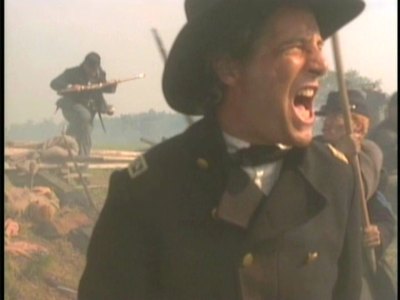
Civil War Combat: The Hornet's Nest at Shiloh
On the morning of April 6, 1862 at Pittsburg Landing, Tennessee, Confederate forces under Generals Johnston and Beauregard launched a surprise attack that nearly defeated Grant's Army of the Tennessee. Confusion on the Confederate lines and last-minute Union reinforcements gave Grant the victory, but with over three thousand dead and nearly twenty-thousand wounded, the two-day Battle of Shiloh showed both sides of the brutal face of a war that had barely begun.
Civil War Combat: The Bloody Lane at Antietam
On September 17, 1862, Union General McClellan - possessing superior numbers, an advantageous position, and his opponent's battle plans - managed, through an excess of caution and poor execution, to turn an overwhelming rout of Confederate forces into a "strategic victory." In that one day, more Americans were killed in battle than on any other day in the nation's military history. The battle of Antietam halted Lee's advance into Maryland - but cost McClellan his career.
Civil War Combat: The Wheatfield at Gettysburg
Ordered by General Meade to take a position at Cemetery Ridge, Union Major General Sickles instead repositioned his III Corps half a mile away at the Peach Orchard, exposing his company to attack from multiple sides and forcing Meade to send waves of reinforcements across twenty exposed acres soon to be known as the "Bloody Wheatfield." After just a few hours of confusing back-and-forth battle, thousands of men lay dead or dying.
Civil War Combat: The Tragedy at Cold Harbor
In March, 1864, General Ulysses Grant took supreme command of the Union army with one goal - relentless pursuit of Confederate General Robert E. Lee. Grant and his army caught up to Lee near the crossroads of Cold Harbor, launched a nearly suicidal assault against entrenched Confederate forces, losing seven thousand men in just minutes - a battle one Rebel officer called "murder." The ten-day massacre cost the Union over twelve thousand men, but was Lee's final victory.
Taken from 1999's cable series, Civil War Combat: America's Bloodiest Battles hosted by Roger Mudd, the next four documentaries in the America at War boxed set look specifically at four famous engagements from America's bloodiest conflict, giving the viewer a terrifically detailed account of each through vivid narration, expert commentary, and graphically rendered battle re-creations by Civil War reenactors. While of course Ken Burns' The Civil War has set the bar for all such documentaries on the subject, it's not the be-all, end-all take on these hostilities, and the docs from this series are admirably concentrated on the precise set-ups, engagements and aftermaths of these battles (the politics and strategies that shape the battles aren't forgotten, but clearly, the battles themselves are the main focus here). While Burns' emotionalism certainly is compelling, these tidy little docs, written, produced and directed by Jim Lindsay and David DeVries, provide a concrete, detailed look at these engagements, told without the florid fanfare of Burns' efforts, offering a nice counterpoint to what has almost become a cliche in Burns' approach.
Narrative in nature, with voice-over accompaniment from actual diaries and letters of the commanders and soldiers involved, these docs are surprisingly grim, bloody interpretations (with an occasional dose of gore thrown in), nicely shot on-location at what I assume are the actual battle sites (an apparent smaller budget limits the number of reenactors used, but it doesn't detract from the overall effect). Commentary outside the narrative framework is less-than-usual here, with writers, historians and authorities Wiley Sword, Stacey D. Allen, Maureen Harp, Gary Gallagher, Robert Krick, D. Scott Harting, Edwin Bearss, Eric Campbell, Gordon Rhea, and E. B. Furguson lending their expertise to the proceedings. Civil War enthusiasts looking for concise, detailed accounts of the above battles will do well here, and newcomers to this monumental moment in American history will find the Civil War Combat series a sobering, relentless look at the inconceivable carnage that almost tore this nation apart. Small, tidy, and grim. On a side note: the video quality may not be the best here, but the Civil War Combat transfers do have the distinction of being the only closed-captioned offerings here in the America at War boxed set.
VOLUME SEVEN: WORLD WAR I
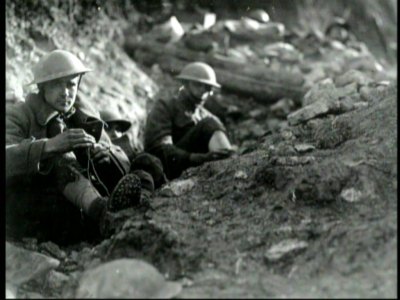
The Death of Glory, Parts 1 & 2
Beginning with a double murder in Sarajevo, the "War to End All Wars" set the stage for even deadlier conflicts. Battlefield chivalry and honor yielded to the impersonal U-boat and poison gas, the devastating firepower of tanks and machine guns, and trench warfare. Nations disappeared from the map of Europe as the seeds were planted for the rebirth, merely twenty-one years later, of a new and deadlier German juggernaut.
Produced in 1997 by veteran TV documentary producers Lou Reda, Sammy Jackson and Mort Zimmerman, and written by Norman Stahl with Col. Rod Paschall, director Don Horan's World War I: The Death of Glory is an excellent two-part overview of the "War to End all Wars," that mixes archival newsreel footage and actual battle camerawork with some fascinating commentary on the real causes of this horrific conflagration. I suppose if a pop quiz was thrown at me out of the blue, and I was asked what was the single cause of WWI, I would probably remember "alliances" from my high school history class. However, World War I: The Death of Glory posits that the true causes of this generational genocide were not only that handy excuse, nor necessarily opposing ideologies (although the media certainly made the most with that), but rather the efforts of empires to stabilize their holdings, gaining respect from upstart nations, plain and simple score-settling with centuries-old enemies, and of course, business.
Crammed with considerable detail as to names, dates, events, and figures, World War I: The Death of Glory, narrated by stalwart actor Fritz Weaver, manages a memorably icy, ironic atmosphere of utter senselessness as the incredible facts of this first world war are put forth (for instance, one must gape when the film states that France lost 300,000 men alone in the first three months of 1914, or that by the end of 1916, England had lost 607,000 young men in battle - facts like that stagger one's imagination). Adroitly scripted by vet Norman Stahl (the narration is almost poetic in its simplicity), World War I: The Death of Glory moves quickly, using the expert opinions of Dr. Gerhard Weinberg, Johan Ahr, Robert Crowley, Brig. Gen. Edwin Simmons, David Trask, Col. Rod Paschall, Greg Oviatt, and John Votaw to paint a portrait of utter madness and absolutely senseless slaughter in the service of country and money. It's a harrowing account, perhaps not as thorough or as polished as newer efforts on the subject, but still highly valuable as an introduction to the subject.
The Last Day of World War I
On November 11, 1918, known as Armistice Day, the "Great War" was declared over and Allied victory seemed assured. Yet thousands of men would die that day. Allied leaders, seeking promotion or vengeance, manufactured outrageous excuses to send troops against a defeated enemy. The territories won would be returned to Germany, while the soldiers were sacrificed for vanity.
Based on Joseph Persico's book, 11th Month, 11th Day, 11th Hour, this sickly fascinating documentary details the final day of World War I, where Allied and Axis commanders continued to throw soldiers at each other in one last hideous symbolic death shrug. Featuring commentary by Persico, Col. Rod Paschall, Mitch Yockelson, Greg Oviatt, this Norman Stahl-written (with an assist by Persico) doc, produced and edited by veteran doc producer Sammy Jackson, presents a vision of the Great War that encompasses all the waste and carnage that so epitomized that worthless military farrago. Hypnotic use of beautiful, haunting silver plate prints of soldiers on the front lines, this doc is a real gem among these other fine offerings.
VOLUME EIGHT & NINE: WORLD WAR II
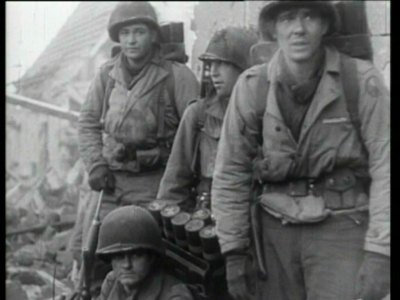
The Last Days of World War II
Defeat after defeat sent Hitler's plans for global domination spinning inexorably out of control, and Nazi leaders scrambled to protect their treasures and secrets at all costs. Meanwhile, the advancing Allied forces discovered the unimaginable depth of Nazi depravity as they liberated the infamous extermination camps hidden in plain sight throughout eastern Europe. A string of strategic, political, and diplomatic blunders sealed the fate of the Third Reich as Berlin fell in flames and Hitler died in his bunker along with his wife and his dog. The Allies exerted a final successful push in the Pacific Theater. And on September 9, 1945, the deadliest war in human history formally came to an end. Finally, the world demanded justice at the unprecedented Nuremberg trials, as a new type of conflict loomed on the horizon - The Cold War.
Produced in 1995 by veteran doc filmmakers Craig Haffner and Donna E. Lusitania, The Last Days of WWII opens America at War's coverage of second "War to End all Wars," a worldwide firestorm responsible for the deaths of at least 60 million men, women and children. Considering the magnitude of the event, and the scores of documentaries that have been devoted to "The Big One, WWII," it would be impossible for any general boxed set devoted to the comprehensive, all-encompassing subject of "America at war" to include a broad enough selection to adequately cover this moment in history. What is presented here on WWII in the America at War boxed set is fascinating, although I question the inclusion of a doc on a specific naval altercation when more broader subjects (such as the entire Pacific campaign) are ignored.
As for The Last Days of WWII, it's chock-full of "talking heads" commentary by historians, authors, experts, soldiers, commanders, and survivors of the war who add a level of gravity and seriousness to the film that is admirable. Divided into three separate segments - Death of the Reich, Justice at Nuremberg and The Spoils of War, The Last Days of WWII tackles these three aspects of the war with a directness and simplicity that some may not call "documentary art," but which presents valuable information in an energetic and compelling manner. Death of the Reich details the Nazis "Battle of the Bulge" campaign, their scorched earth policy in Russian and in the Balkans, the Dresden firebombing incident, the Remagen bridge assault, Hitler's bunker demise, the Holocaust atrocities and the growing Russian threat. Justice at Nuremberg gives a unique look at the trials that put various Nazi leaders on trial for war crimes (there's quite a bit of courtroom footage I had never seen before), with the second half looking at the mystery of Herman Goering's suicide cheating the hangman. And The Spoils of War is a absorbing look at the Monuments, Fine Arts and Archives division of the army that went around Germany (and the Soviet-controlled zones of influence), spiriting away cash and invaluable works of art, before the Bolsheviks could appropriate them back to Russia (I had never heard of the Weisbaden Manifesto, that declared America couldn't ship valuable art objects confiscated from the Nazi treasure holds, after a disastrous publicity tour of priceless paintings in the U.S.). Commentators include Stephen Ambrose, Tom Allen, Lt. Gen. Henry Kinnard, Gerhard Weinberg, Belton Cooper, Alfred Witte, August Graf Kajeneck, David Golubitsky, Pavel Sheykhet, Moisey Dubinsky, Paul Nitze, John Keegan, Paul Shuster, Siegfried Knappe, Angela Thompson, John Iorio, Helmut Gunther, Dr. Klaus Goldman, Norman Polmar, Lynn Nichols, Forrest Dixon, Walter Farmer, Joel Fisher, Kenneth Alford, Bernard Taper, Irina Antonova, Robert Strobell, Bruce Ashcroft, Hans Amtmannn, and Michael Neufield. All in all, a very speedy, thorough going-over of the last days of the Nazi Reich.
USS Eagle 56: Accident or Target?
In April 1945 as the Allies closed in on Berlin, the USS Eagle 56, a World War I-era ship towing targets for torpedo bombers off the coast of Maine suddenly exploded, killing forty-nine officers. Survivors reported seeing suspicious naval activity around the ship, but the U.S. Government insisted it was an accident. Now, sixty years later, the government has confirmed that the USS Eagle 56 was sunk by a German submarine in U.S. waters as the Reich's final act of aggression.
An episode of the History Undercover cable series hosted by Arthur Kent, USS Eagle 56: Accident or Target?, produced by Kevin Bachar and written by Jaime Bernanke, tells the riveting story of the USS Eagle 56, a Navy training vessel that was sunk off the Casco Bay in the Gulf of Maine. An naval inquiry originally blamed the crew for a boiler malfunction, ignoring the eyewitness reports of the surviving sailors who spotted a submarine in the water after the explosion. Due to the dedication of a crusading lawyer and the few surviving navymen (Paul Lawton, John Scagnelli, John Breeze, Harold Petersen), the Navy eventually changed its ruling (unheard of) and declared the explosion the result of enemy action - allowing the sailors to receive their Purple Hearts. It's a terrific mystery, but its focus is awfully narrow for inclusion in a boxed set like this, particularly when there are so many other, larger themes that could have been covered (such as the entire Pacific campaign).
Last Secrets of the Axis
Behind the most notorious men of the Nazi regime stood the little-known geography professor Karl Haushofer, who coined the term "geopolitics," and whose obsession with Japan's cults and secret societies may have shaped Hitler's vision of global Aryan domination. Other Axis secrets included German and Italian support of a coup in Iraq that had the goal of establishing a Persian Gulf base for Japanese submarines.
Written by George Kerevan, Last Secrets of the Axis is a 2001 History Channel special that looks at the now-forgotten legacy of Karl Haushofer, Hitler's "Merlin" who may have had the single greatest influence on the Nazi leader's formative thinking in terms of geo-political theory. Frankly, I had never heard of Haushofer, so I found this piece quite compelling. Haushofer's link with Japanese secret societies (the Black Dragons, specifically, which then morphed into the modern day yakuza), and his influence in bringing together German and Japan as formidable Axis allies, is intriguing stuff (as well as Haushofer's linking of Japanese symbolism with Aryan ideals of supermen, and his role in recruiting a key German spy who tipped off the Japanese during the Pearl Harbor bombing). It's an entertaining doc, with a fascinating story to tell.
VOLUME TEN: THE KOREAN WAR
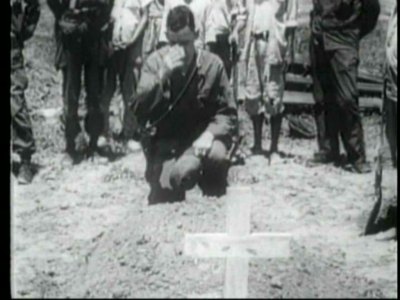
The Korean War: Making of a Bloodbath
On June 25, 1950 North Korea surged across its southern border, catching South Korea and its allies off guard. U.S. and United Nations forces acted swiftly, but faced the likelihood of a humiliating evacuation.
The Korean War: Triumph to Tragedy
With U.N. forces on the verge of defeat, Supreme Commander Douglas MacArthur masterminded a brilliant landing at Inchon. The onslaught of hundreds of thousands of Chinese troops forced the Americans to make a desperate retreat.
The Korean War: Retreat from Hell
As American forces were nearly overrun, they engaged in the largest retreat in U.S. history. By December of 1950, the Communists recaptured Pyongyang. In January, Seoul fell as both sides dug in at the 38th Parallel.
The Korean War: Bitter Standoff
American casualties mounted, as did the pressure to end the war. Truman replaced MacArthur with General Matthew Ridgeway, who retook Seoul. U.S. policy shifted from liberation to containment until the armistice of July 1953. Technically, North and South Korea were still at war.
Originally known as The Korean War: Fire and Ice, this three hour documentary from 1999, produced by veteran TV doc producer Lou Reda, and written by Norman Stahl, Joseph Alexander, and Col. Rod Paschall, is one of the best all-around documentaries on Korea, the "Forgotten War," I've ever seen. Using a plethora of first-rate newsreel and battle footage, along with some compelling expert commentary, the four-part film tells you exactly how the Korean War began, how it was fought, and how it dragged on to essentially a fifty-year-plus stalemate. And one point in the film, someone comments on the differences between the U.S. commanders and soldiers, and the Communist forces, labeling them chess players, while we Yanks were poker players. It's a brilliant observation, perfectly summing up and putting into context the mistakes and victories both sides committed.
Admirably, the doc doesn't shy away from calling a spade a spade, either, correctly identifying the occupying U.S. forces called up to Korea as weak and poorly trained and equipped (and led, at least at first), as well as calling out the North Koreans and Chinese for the barbaric, horrific atrocities they committed on South Korean civilians, U.S. servicemen - and their own men, with their military strategy of using expendable waves of human cannon fodder. It's a bracing, lucid examination of a war that seems perpetually fogged (if it's remembered at all, shamefully) in the general public's mind. Speakers on camera include Donald Gregg, Col. Robert Black, Col. Rod Paschall, Lt. Gen. Bernard Trainor, Bevin Alexander, Col. Joseph Alexander, Dr. Edward Marolda, Raymond Donnelly, Dr. Richard Hallion, Lt. Col. Sherman Pratt, Joe Cappella, Col Harry Maihafer, Col. Harry Summers, Frank Fonseca, Anthony Fernandes, Capt. Thomas Hudner, Paul Martin, Danny DiTonno, Harley Coon, Paul Stillwell, B. F. Saxton, Al Ortiz, Bernard Iammatteo, John Calvo, and Col. Robert Gerard.
VOLUME ELEVEN: THE VIETNAM WAR
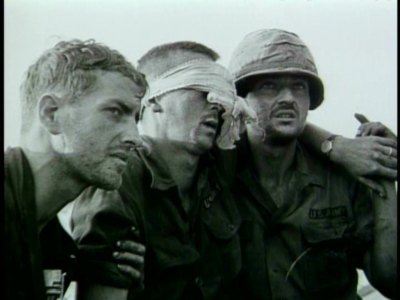
Vietnam: On the Frontlines: America Enters the War
Courageous U.S. soldiers in Vietnam, both on land and in the air, faced an unrelenting enemy in bloody battles at Ia Drang Valley, Khe Sanh, Con Thien, and Dak To.
Vietnam: On the Frontlines: Tet in Saigon and Hue
In January 1968, during the Tet holiday cease-fire, the North Vietnamese and Viet Cong attacked over one hundred cities and bases in South Vietnam. The bloodiest battle, near the ancient capital of Hue, inflicted a fifty percent U.S. Marine casualty rate.
Vietnam: On the Frontlines: Ringing Down the Curtain
As Nixon withdrew troops from Vietnam, he orchestrated an incursion into Cambodia. On Easter 1972, North Vietnamese swarmed into South Vietnam.
Vietnam: On the Frontlines: The End Game
U.S. Marines rescued almost seven-thousand people - both Americans and South Vietnamese - in the hours before Saigon fell to the Communists.
A special four-part, three-hour miniseries from The History Channel, 2000's Vietnam: On the Frontlines is a gripping, nervy presentation of some of the major battles and engagements in the tragically misunderstood (read John Keegan) and fatally executed Vietnam War. Immediately jumping into battle with extensive color footage courtesy of the CBS journalists who were covering the war at the front, Vietnam: On the Frontlines presents first-hand accounts of some of the most harrowing, horrific encounters our G.I.s encountered in Vietnam. In-depth policy discussion is kept to a minimum, except for the most basic theories that directly affected practical military applications (President Johnson, misguided from the start, felt that incremental force would send a "message" - a message that got G.I.s killed and that nobody wanted to hear in North Vietnam; Nixon amped up the violence and successfully waged war against the NVA, and then left the South Vietnamese civilians holding the bag as we essentially abandoned the country with Ford), while the terrors and frightening calamities that befell the brave U.S. soldiers are rightly highlighted.
Context is limited, such as when the film discusses the falling public opinion polls about the war, but fails to mention the role the media had in fostering those opinions, including having anchormen like Walter Cronkite essentially "call" the war (but what else would you expect from a CBS co-production?). Correctly, the film does allow the G.I.s who did the fighting to comment (negatively) on the young protestors at home who offered aid and comfort to the enemy through their vilifying indictments against the soldiers in the field. Raw, sometimes stunning battle footage is featured throughout the four parts, while soldiers, commanders, journalists and historians such as Col. Cole Kingseed, Col. Harold Moore, Lt. Dennis Deal, Lt. Larry Guinn, George Forest, Col. Conrad Crane, Bob Pardo, Ed Rasmuss, Maj. David Toczek, Sgt. John Steer, Sgt. Angie Scarino, Col. Ken Smith, John Laurence, Capt. Michael Lambert, Lt. Gen. Ernes Cheatham, Bill Purcell, Lt. Gen. Ron Christmas, Robert Carroll, Col. Bob Thompson, Maurice Whitmer, Col. Myron Harrington, Norman Lloyd, Bruce Dunning, Mike Marriott, Lt. Col. Jim Kean, Kenneth Moorefield, Brian Ellis, Col. Gerry Berry, Maj. Warren T. O'Hara, and Col. Darrell Browing contributing spellbinding, first-hand reminiscences.
VOLUME TWELVE: THE GULF WAR
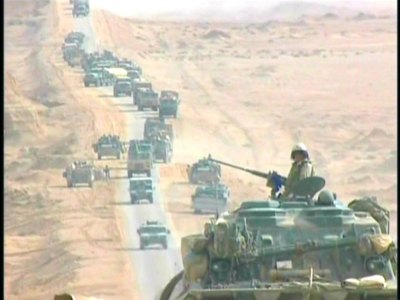
Operation Desert Storm: The Air Campaign
Tomahawk missiles, Stealth bombers, traditional F-111 and F-5 bombers, and Apache and Cobra helicopters cleared the way for the war on the ground.
Operation Desert Storm: The Ground War
A new generation of tanks, global positioning systems and the Joint Surveillance Target Attack Radar System (Joint STARS) allowed the coalition to carry out General Schwarzkopf's bold plan in only four days.
Operation Desert Storm: The Final Showdown
The Republican Guard made a desperate effort to stop the coalition advance, while Iraqi forces destroyed Kuwait's infrastructure and industry.
Originally entitled Beyond Desert Storm, a 2001 three-part miniseries on the 1991 Gulf War, Operation Desert Storm is a detailed examination of the political forces that converged in 1991 to convince the United Nations and a willingly coalition of Western and Arab nations to take out a defiant invader of Kuwait, Saddam Hussein. Correctly identifying the threat that Saddam's weapons of mass destruction posed to the Middle East and specifically Israel (according to U.N. inspectors and every single Western intelligence agency), the documentary is fair in acknowledging that the U.S.-led invasion had to err on the side of caution when dealing with such weapons. As well, the doc correctly identifies the feelings of disappointment and confusion that were present immediately after ground operations were suspended only 100 hours after they began, when it became apparent that President Bush, with the advice of Colin Powell, had bowed to perceived pressures concerning our Arab allies, eventually creating a worse situation in the Middle East than when Bush first invaded.
As well, the doc correctly identifies the unrealistic attitudes of the American public concerning war, fostered by the incredibly low number of combat casualties in this skirmish, attitudes that continue to hamper U.S. political decisions concerning military operations today. Leaders aren't let off the hook (General Schwarzkopf's "mother of all lies" news conference; Bush's and Powell's timidity in pursuing total victory when it was within arms' reach), while the brave soldiers and commanders who performed with such lightening speed and coordinated skill (due in part to the advanced weapons systems that were quantum leaps for the military in this war) are given their just due. Commentators include William Arkin, Maj. Gen. Dave Deptula, Col. Walter Boyne, Dr. Richard Hallion, Lt. Gen. Bernard Trainor, Andrew Leyden, Lt. Gen. Buster Glosson, Capt. David Bill,, Rick Atkinson, Gen. Chuck Horner, Lt. Col. Paul Johnson, Gen. Walter Boomer, Dick Cheney, Maj. Gen. John Admire, Maj. Gen. Ron Richard, Maj. Gen. Jerry Humble, Lt. Col. Randy Hammond, Lt. Col. Ralph Hayes, Col. Kenneth Steinveg, Col. Bill Mulvey, Michael Gordon, Lt. Gen. Fred Franks, Maj. Gen. Ronald Griffith, H. R. McMaster, Gen. John Yeosock, Lt. Gen. Thoms Rhame, Lt. Col. Merrick Krause, Philip Zeilikow, Lt. Gen. Calvin Waller, and Lt. Gen. Barry McCaffrey.
Weapons of War: Smart Bombs
America discovered a unique new war weapon: the precision-guided munitions known as "Smart Bombs." Delivering devastating payloads with unprecedented accuracy, these satellite-guided weapons could target individual buildings in central Baghdad itself, eliminating their targets while causing a minimum of civilian casualties.
An episode of the excellent Weapons at War series from 1993, hosted by Gerald McRaney, this doc looks at the smart bomb technology, as well as the integrated GPS systems and coordinated command structures that moved the U.S. military even further into the forefront as the most deadly, most efficient fighting force in the world. Smartly produced and fast-moving.
VOLUME THIRTEEN & FOURTEEN: THE IRAQ WAR
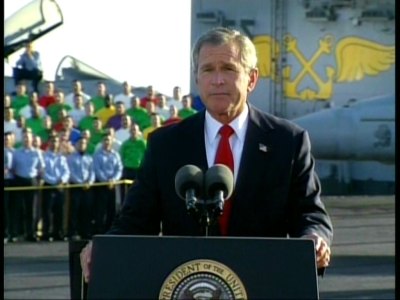
One Year Later: Invasion
From the devastating event of September 11, 2001 to President Bush's declaration against the "axis of evil," to U.N. negotiations, invasion, and the end of combat operations, this program explores what decisions were made, which worked, and why they were successful.
One Year Later: Tough Going
The air war against Iraq progressed as planned until the capture of a number of U.S. combatants, including an Apache Longbow helicopter crew and Private Jessica Lynch, reshaped the expectations held by American at home.
One Year Later: Baghdad's Doorstep
As the Third Infantry took the critical Karbala Gap and Baghdad Airport, Kurds and Special Forces moved toward Mosul and Kirkuk, and Allied planes flew two thousand sorties a day. Finally, the Third Infantry made its first foray into Baghdad.
One Year Later: Fall of Saddam
Marines helped pull down a statue of Saddam as Iraqi Army units melted away. Kurds and Coalition Special Forces captured Kirkuk and Mosul, and Task Force Tripoli took Tikrit more easily than expected.
One Year Later: Aftermath
In May 2003, as President George Bush stood in front of a banner reading "Mission Accomplished," the lack of infrastructure caused chaos in Iraq, and mass looting ensued. Soldiers taught to fight were now being trained "on the job" as occupiers while more U.S. soldiers died in post-war operations than during the war.
Certainly the most controversial of the documentaries included in the America at War boxed set, this five-part 2004 documentary looks unflinchingly at the successes and mistakes made in the beginning years of the current Iraq War, presenting a fair and balanced look at what America did wrong, and what it did right in taking out Saddam Hussein. All the major theories are presented here (in other words, the ones you won't hear on the Big Three networks), including the widely held belief at the time (including all those politicians who claim otherwise now) that all reliable intelligence pointed towards Saddam having weapons of mass destruction.
Thankfully, those conveniently forgotten, uncomfortable realities of the terrorists we were fighting are presented here by the soldiers who were actually on the ground (dual use facilities to guarantee Western mainstream media outrage at Western "aggression," the cowardly "insurgents" who routinely hid behind women and children before ducking into mosques), as well as a nightmarishly realistic evaluation of the size and scope of the problems we encountered in trying to bring democracy to Iraq; armchair gripers may find themselves silent when they see the enormity of the task facing the U.S. military in Iraq - and the overall splendid job they've done there (with an infrastructure already destroyed by Saddam's neglect, rebuilding is extensive and ongoing). There's no effort to hide the fact that the U.S. was woefully unprepared for the civil war that followed the successful ground attack (please: can we finally retire the old saw about Bush saying, "Mission Accomplished" - which he didn't - as if it somehow meant the entire job of occupation was done, as opposed to just the major assault?), but there's also an effort to show the great strides the military made after the dark days of 2004 to understand the true nature of "insurgency," and how best to counter it (a lot of blue fingers went up in the air, to the great indifference of the Western media).
Of course, this kind of even-handed treatment of the U.S. occupation will set a great many teeth on edge, but the documentary is quite cognizant in recognizing that the greatest threat the U.S. has ever faced in Iraq is its own fear of bad publicity; political decisions were made to satisfy unsatisfiable critics, and the military efforts suffered accordingly. That message - let the military do what it does best: fight - is a message our politicians on both sides of the aisle (particularly those who shrewdly conceal their contempt for the services) seem to forget, time and time again. Commentators include Lt. Col. Michael Moseley, Maj. Clint Hihote, Lt. Col. David Toomey, Harlan Ullman, Col. Larry Brown, Dr. Daniel Goure, Bruce Berkowitz, Gen. Ron Foglemann, Lt. Gen. James Conway, Lt. Gen. David McKiernan, Maj. Edward Boheman, Maj. Gen. Buford Blount, Michael Vickers, Gen. Richard Myers, Maj. John Altman, Sgt. James Birdsong, Maj. Gen. Dan Leaf, Col. Will Grimsley, Capt. James Lockridge, Capt. Matt Morgan, Maj. Brad Gavle, Lt. Col. Eric Wesley, Brig. Gen. Terry Robling, Capt. Jason Smith, Lt. Jonathan Derosier, Col. Joe Dunford, Brig. Jim Dutton, Col. Thomas Waldhauser, Sgt. Jacob Lupton, Cpl. Mike Breslin, Capt. Bob Harwood, Chief Petty Off. Randy Cook, Gen. Benjamin Freakley, Chief Warrant Off David Williams, Ronald Young, Lt. Col. John Charleton, Brig. Gen. Rich Natonski, Lt. Col. Jeffrey Sanderson, Col. Ron Bailey, Lt. Col. Glenn Sternes, PFC Patrick Miller, PFC Shoshana Johnson, Col. Jean Malone, Brig. Graham Binns, Lt. Rick Schwartz, Lt. Gen. Scott Wallace, Col. James Kowalski, Lt. Franklin Heath Freeman, Lt. Dan Francis, Capt. Brian Lewis, Sgt. James Mares, Maj. Chris Lewis, Maj. Chris Ellinger, Sgt. Orion Steele, Lt. Paul Block, Sgt. Andrea Calise, Sgt. Jarvis MacNeill, Lt. Joe Runchi, Capt. Chris Watchman, Lt. Col. Buster Howes, Lt. Col. Gordon Messenger, Maj. Gen. Pete Osman, Staff Sgt. Christopher Cerillo, PFC Patrick Riley, James Dobbins, Paul Bremer, Michael Einstadt, Judith Yaphe, Maj. Gen. Robert Scales, Sgt. Arthur Wells.
The DVD:
The Video:
The full-screen, 1.33:1 video transfers for the various documentaries in the America at War boxed set vary in quality, with the newer docs obviously faring better as far as picture clarity and color, as opposed to the some of the older titles (such as The Revolutionary War, where considerable video noise and grain is apparent. As with most History Channel releases, compression issues do crop up (particularly interlacing), but considering what these films are, video fidelity isn't the highest priority.
The Audio:
The Dolby Digital English 2.0 stereo mixes for the documentaries in the America at War boxed set are for the most part, relatively clean and crisp, with all dialogue heard correctly, but with little directional effects. With the exception of The Civil War discs, none of the docs come with optional subtitles or close-captioning options.
The Extras:
Three extras "bonus" episodes fill out discs 13 and 14: Eyewitness in Iraq, a widescreen doc featuring the still photography of mainstream journalists in Iraq; U.S. Weapons Against Iraq, a History Undercover episode from 2002 that details the many "smart" weapons planned for use in Iraq by coalition forces, during the long wait to war once Iraq's stalling tactics finally ran out (thanks, U.N.), and Iraq War: Insurgency and Counterinsurgency, a terrific examination from 2005 of the obstacles that met the unprepared coalition forces after the major assault was over, and the heroic efforts of the U.S. military to continue training the equally brave Iraqi police force to take control of their own country.
Final Thoughts:
Like it or not, we are a warrior nation, with a rich tradition of military exploits that have shaped and defined our past and our destiny. Understanding that concept is key to understanding who we are, how we came to be Americans, and where we possibly may go in the future. Certainly the documentaries in the America at War boxed set aren't of such a profound nature that they're a be-all, end-all primer on the complex notion of "America at war," but they're a good start - particularly when viewed as a whole. Scholars and students of history will find these docs stimulating starting points, while military and history buffs may enjoy another entertaining take on their favorite period in America's military timeline. The selections aren't perfect by any means, but the sheer breadth of the material covered is impressive. I highly recommend the America at War boxed set.
Paul Mavis is an internationally published film and television historian, a member of the Online Film Critics Society, and the author of The Espionage Filmography.


|
| Popular Reviews |
| Sponsored Links |
|
|
| Sponsored Links |
|
|
| Release List | Reviews | Shop | Newsletter | Forum | DVD Giveaways | Blu-Ray | Advertise |
|
Copyright 2024 DVDTalk.com All Rights Reserved. Legal Info, Privacy Policy, Terms of Use,
Manage Preferences,
Your Privacy Choices | |||||||














